Steelhead in the Morro Bay watershed face many challenges including climate change, predation by non-native pikeminnow, and limited access to high-quality habitat. As a “threatened” species and an excellent indicator of stream health, the protection, monitoring, and restoration of steelhead populations and their habitat is an important component of the Estuary Program’s watershed stewardship efforts.
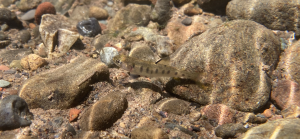
To best target our efforts to improve conditions for steelhead to thrive, we need to understand where steelhead are in the watershed. Traditional monitoring methods include snorkeling, electrofishing, or installing trap systems. While these methods can provide valuable data, they are time-intensive and can disturb the fish. In recent years, environmental DNA (eDNA) has emerged as a non-intrusive, cost-effective tool for gathering data on the whereabouts of elusive fish like steelhead.
Sampling for Environmental DNA
Many aquatic organisms release DNA into the stream environment through shedding, feces, mucus, or decaying tissue. By collecting a water sample and filtering it, we can capture those traces of DNA and send them to a lab for genetic sequencing.
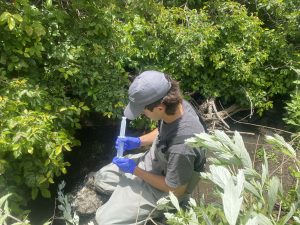
San Luisito Creek Steelhead Restoration
Over the last century, human influences in the watershed such as road crossings and other infrastructure have created fish passage barriers, which are obstructions that prevent fish from migrating and accessing habitat. Some barriers only limit fish passage during certain flow conditions or for specific sizes of fish such as smaller juveniles. Others inhibit passage under all flow conditions for all life stages. San Luisito Creek, a major tributary of Chorro Creek, historically provided about five miles of high-quality stream habitat for steelhead. Today, steelhead have unimpeded access to only about a half mile of the creek.
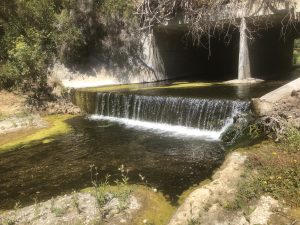
The extent to which barriers limit fish passage is determined by factors such as the depth of the pool below the barrier, the height of the barrier, and the stream flow velocity. Based on these metrics, the barriers on San Luisito Creek at Adobe Road and at Highway 1 completely prevent fish passage during average flow conditions. During high flow conditions, it may be that only the biggest fish can make the jump and reach the habitat upstream.
To better understand where steelhead are and how barriers affect their ability to move upstream, we collected eDNA samples upstream and downstream of three known barriers on San Luisito Creek.
eDNA Results on San Luisito Creek
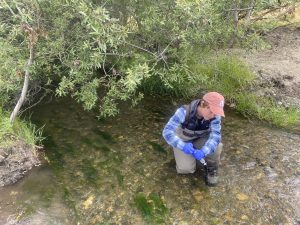
The monitoring results indicated the presence of steelhead DNA upstream of both the Highway 1 barrier and the Adobe Road barrier. The results above a third barrier further upstream did not indicate the presence of steelhead.
So how is it that steelhead DNA was detected upstream of two fish passage barriers? Possibly some steelhead were able to successfully navigate these barriers during high flow events and spawn upstream. Another possibility is that a resident population of steelhead became established before the formation of the barriers. Either way, the presence of these fish in the creek demonstrates that the habitat upstream of the lower two barriers is supportive of sensitive steelhead.
The uppermost barrier blocks fish passage entirely, and apparently no resident population of steelhead exists upstream of it.
Sampling for eDNA can also help guide management efforts for pikeminnow, an invasive fish that preys on juvenile steelhead. In 2019, the Estuary Program funded a project that involved collecting an eDNA sample upstream of the Adobe Road barrier and results show that these non-native fish were not present in San Luisito Creek. This year, we again tested the location and found no DNA evidence of pikeminnow.
Next Steps
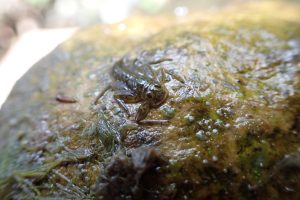
Other monitoring efforts by the Estuary Program show good water quality and bioassessment scores on San Luisito Creek. These findings highlight the importance of removing barriers to allow for year-round fish movement between this high-quality habitat and the rest of the watershed. The Estuary Program is working with partners to implement a project to restore fish passage at this site.
To support the effort, we will continue using eDNA as a tool to improve our understanding of the distribution of steelhead and pikeminnow in the watershed and to help prioritize restoration efforts.
Help us protect and restore the Morro Bay estuary!
- Donate to the Estuary Program today and support our work in the field, the lab, and beyond.
The Estuary Program is a 501(c)3 nonprofit. We depend on funding from grants and generous donors to continue our work. - Support us by purchasing estuary-themed gear from ESTERO. This locally owned and operated company donates 20% of proceeds from its Estuary clothing line and 100% of Estuary decal proceeds to the Estuary Program. Thank you, ESTERO!
- Purchase items from the Estuary Program’s store on Zazzle. Zazzle prints and ships your items, and the Estuary Program receives 10% of the proceeds. Choose from mugs, hats, t-shirts, and even fanny packs (they’re back!) with our fun Estuary Octopus design, our classic Estuary Program logo, or our Mutts for the Bay logo.
- We want to hear from you! Please take a few minutes to fill out this short survey about what type of events you’d like to see from the Estuary Program. We appreciate your input!